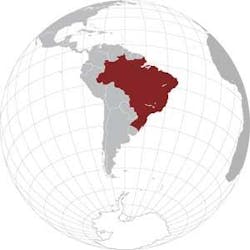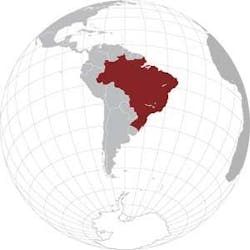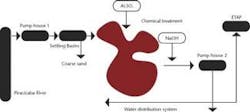Brazilian steel producers invest heavily in water recirculation
By Dayse Abrantes, Peter Howard Wertheim
Two Brazilian steel producers, Usinas Siderurgicas de Minas Gerais SA (Usiminas) and its affiliate, Companhia Siderúgica Paulista SA (Cosipa), have invested heavily in water treatment and recirculation technology to reduce raw water intake from the Piracicaba River.
According to Usiminas President and Chief Executive Officer Rinaldo Campos Soares, the quality and availability of industrial water must be considered before embarking on steel mill expansion projects. He explained: "Besides enabling the treatment of the water to assure the quality required for industrial processes and rationalising the use of water thus reducing costs, water recirculation units assure operational continuity and environmental preservation because they reduce water intake from the river." Less water intake is a key factor for expanding the productive capacity of the company by decreasing the demand for infrastructure construction and installations, such as water supply networks and water discharge systems, he said.
Usiminas is one of the largest steel producers in Brazil with an output of around 4.7 million tonnes/year of crude steel. Usiminas holds a 38% share of the domestic market, which resulted in net revenues of US$ 2.2 billion in 2002. Usiminas holds a 93% interest in its affiliate Companhia Siderúgica Paulista SA (Cosipa). Together, their yearly raw steel output reaches 9.2 million tonnes.
Provided by Usiminas
"Both mills make up the biggest steel group in Latin America and one of the world's 20 largest steel producers. The Usiminas system is comprised of 17 companies, two private sea terminals, four service centers, five distribution centers and one of the most modern research centers in Latin America's steel industry, plus three welfare institutions," Soares told Water & Wastewater International.
Usiminas' corporate headquarters are located in Belo Horizonte, state capital of Minas Gerais. Its industrial plant, Usina Intendente Câmara (steelworks), occupies 10.5 km2 in the city of Ipatinga, within the state, in the region known as the Steel Valley, close to one of the world's largest iron ore reserves.
Soares said that Usiminas is the first Brazilian integrated steel producer and second in the world to be granted the ISO 14.001 certificate. "In 2002 we had the third audit by Det Norske Veritas (DNV) which recommended the certificate revalidation for three more years, thus attesting the company's commitment to sustainable development and compliance with environmental legislation." The company invested some US$ 500 million in environmental installations and equipment, Soares claims.
Usiminas' environmental policy focuses on the preservation and cleaning up of water resources: "The polluting agent concentration in the effluents disposed by the company comply with all parameters set forth by Brazil's federal environmental authorities." The company decreased raw water intake from 188m3/minute in 1995 to 116.4m3/minute from January to September 2003 (Figure 1). The company reached its target of 109.2m3/minute by the end of December 2003.
The overall system intake capacity is 18,000 m3/hour, the reservoir's capacity (Tapir pond) is 1,200,000 m3 and the distribution is 27,300 m3/hour.
To achieve these targets, Usiminas' water system facilities include: one intake unit; a raw water treatment station (300 m3/minute capacity); a water storage and distribution unit; a drinking water treatment station (24 m3/minute capacity); 19 process water recirculation systems and 94 small-size water recirculation units for air conditioners; four industrial gas scrubbing systems; four effluent treatment stations; a central control unit (power center) and one laboratory for water quality monitoring.
The water quality monitoring includes pH, suspended solids (SS), turbidity, total hardness, iron, silica, sulfates, chlorides, alkalinity and corrosion rate tests. Usiminas returns water to the Piracicaba River through its effluent treatment stations within the standards required by Brazil's tough environmental legislation.
The industrial water treatment stations use natural sedimentation followed by complementary sedimentation with chemical product use. Afterwards, the pH is corrected, making the water usable for industrial purposes.
The conventional drinking water treatment stations use pre-chlorination, sedimentation, filtration, and chemical treatment. The effluent treatment stations use chemical processes, including neutralisation, sedimentation and filtration, and biological processes, such as oxidising and nitrifying bacteria.
Overall water recirculation capacity of the Usiminas plant reached 102,000 m3/hour. The average raw water recirculation increased by 1.7%, reaching an average ratio of 94% in 2002. Compared to the previous year, Usiminas reduced water intake volume from the Piracicaba River by 16.5%, reduced water consumption per ton of steel by seven percent, while increasing water recirculation by 5.7%. This was an impressive reduction in water capturing: from 23.9 m3 per tonne of steel to 13.7 m3 per tonne, a reduction of 74.4%.
In general, Usiminas employs three types of large recirculation units:
• Recirculation for direct cooling systems (the water comes into contact with the product and incorporate residues). This type of system is composed of sedimentation tanks, pressurised filters, cooling towers, pumping units, chemical treatment of the water and systems for removal and draining of residues.
• Recirculation for indirect cooling system (the water does not incorporate residues during equipment cooling). This system is basically composed of pumping units, cooling towers and a system for chemical treatment of the water.
• Water recirculation for systems to clean up gases from furnaces. These units are equipped with pre-sedimentation (classifiers), thickeners (settling), a system for chemical conditioning of the water, pumping units and units for dehydration of mud through vacuum filters.
Liquid effluents generated by the production processes at Usiminas and Cosipa are treated in specific treatment stations. Cosipa's investments during 2002 led to an increase in the fresh waters recirculation ratio to 96%. Altogether, fresh water and brackish water recirculation reached 77%, thus considerably reducing the need for make-up water.
In Usiminas, where the production processes use fresh water only, the average recirculation ratio was 92% in 2002.
In 2002, the effluents were monitored at the outlets of Usiminas' treatment stations, such as those of the electrolytic galvanising line, acid water neutralisation, biological treatment, oily wastes and the general sewer system. These average figures prior to final disposal are shown in Table 1.
Usiminas lowered Piracicaba river intake to less than 109.2 m3 /minute with maximum consumption of 18.8 m3 /tcs; water recirculation ratio equal to or higher than 93.3% by the end of 2003. The company also eliminated liquid effluents contaminated with H2S from BF 1 and 2 also by December 2003.
A stormwater retention basin was constructed at the Ipatinga plant to collect and control the release of accumulated runoff. This was built to accommodate the construction of a new industrial infrastructure and material storage facilities at the Ipatinga plant, necessary to keep up with the Brazilian automotive market which consumes around 30% of Usiminas production.
After reviewing several alternatives, the Presto Geoweb cellular confinement system was chosen to increase the capacity of the existing stormwater retention and drainage system. The system confines the infill material minimising the downward migration of embankment materials by functioning as small check-dams in the upper soil layer. It also offers an aesthetically pleasing green appearance while increasing the soil's erosion resistance by encapsulating and interlocking with the vegetative root zone. The system helps to prevent rills and gullies from forming, particularly in areas of concentrated flow over erosive soils.
The 88-metre-long by 55-metre-wide by six-metre-deep basin was built in a sandy soil area, leaving 30º slopes with a high potential for erosion damage, especially at the water surface level within the basin. Sections of Geoweb 2.44-meter-wide by 6.10-metre-long by 100 mm in depth (8ft x 20ft x 4in) were expanded and anchored with 10-mm-diameter CA-50 steel anchor stakes. The anchored sections were then infilled with two types of material: reinforced concrete in the lower part, where there will be a longer duration of water contact, and topsoil vegetated with grass in the upper part. In order to protect the 5,400 m3 of slopes, 358 Geoweb sections were used.
Authors' Note
Peter Howard Wertheim and Dayse Abrantes are freelance journalists based in Rio de Janeiro, Brazil, who specialise in covering the environment, petroleum, electricity and telecom sectors in Latin America. For more information contact by e-mail: [email protected].



